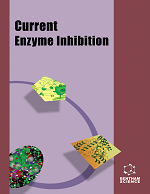- Home
- A-Z Publications
- Current Enzyme Inhibition
- Previous Issues
- Volume 8, Issue 1, 2012
Current Enzyme Inhibition - Volume 8, Issue 1, 2012
Volume 8, Issue 1, 2012
-
-
FOREWORD
More LessWelcome to the edition of the 8th Volume, number 1 of the Journal of Current Enzyme Inhibition. This issue includes four interesting reviews. Two of them are focused on natural products and on their role in cancer and cytotoxicity, one deals with a web based program to understand the essential structural features for a specific biological activity and the fourth presents iminoalditols targeting Carbohydrate processing enzymes. Bei Read More
-
-
-
Impaired Expression and Function of Cancer-Related Enzymes by Anthocyans: An Update
More LessAnthocyans (ACNs), i.e. anthocyanins and anthocyanidins, belong to a widespread group of plant constituents, collectively known as flavonoids, which occur in the western diet at relatively high concentrations. ACNs display a variety of pharmacological properties which make them potential anti-inflammatory and anti-cancer agents. In addition to their ability to scavenge reactive oxygen species, ACNs can affect the functions Read More
-
-
-
Ligand-Based Pharmacophore Detection and Screening of Potential Glitazones
More LessAuthors: Ritesh Agrawal, Pratima Jain and Subodh N. DikshitThree-dimensional pharmacophore hypothesis was built based on a set of known Protein tyrosine Phosphatase 1B (PTP1B) agonists using PharmaGist program to understand the essential structural features for Protein Tyrosine Phosphatase 1B (PTP1B) agonists. The various marketed or under development potential glitazones have been opted to build a pharmacophore model e.g. Pioglitazone, Rosiglitazone (BRL-4965 Read More
-
-
-
The Two Faces of Iminoalditols: Powerful Inhibitors Trigger Glycosidase Activation
More LessAuthors: Tanja M. Wrodnigg and Arnold E. StutzUnderstanding and controlling carbohydrate processing enzymes (CPE) have been major issues and challenges for chemists, biochemists and clinical practitioners alike. One of the most powerful families of substances for probing active sites as well as allosteric interactions with CPEs are basic sugar analogues, in particular iminoalditols. This compound class presents a basic trivalent nitrogen instead of oxygen in the sugar Read More
-
-
-
Cytotoxic Natural Products and their Pharmacological Mode of Action: A Hypothesis on their Complexity and Spectrum of Activity
More LessNatural products are important in pharmaceutical research, and many medicines are based on natural products. It is estimated that about 40% of all medicines and about 60% of anti-cancer agents are based on natural products. Plants, marine organisms, amphibians and soil micro-organisms produce cytotoxic compounds to protect themselves or their micro-environment against other organisms and species. It may be benefic Read More
-
Volumes & issues
-
Volume 20 (2024)
-
Volume 19 (2023)
-
Volume 18 (2022)
-
Volume 17 (2021)
-
Volume 16 (2020)
-
Volume 15 (2019)
-
Volume 14 (2018)
-
Volume 13 (2017)
-
Volume 12 (2016)
-
Volume 11 (2015)
-
Volume 10 (2014)
-
Volume 9 (2013)
-
Volume 8 (2012)
-
Volume 7 (2011)
-
Volume 6 (2010)
-
Volume 5 (2009)
-
Volume 4 (2008)
-
Volume 3 (2007)
-
Volume 2 (2006)
-
Volume 1 (2005)
Most Read This Month
Article
content/journals/cei
Journal
10
5
false
en


